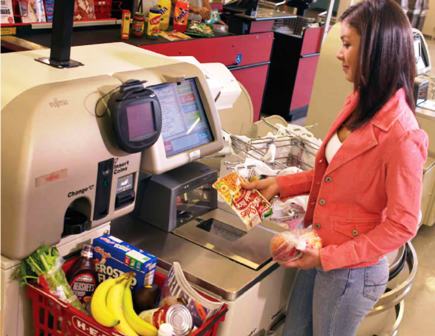 The U-Scan self-checkout system operates like a conventional checkout lane, but it's the shopper -- not the cashier -- who scans, bags, and pays for the purchases, with minimal supervision from the store attendants. Retailers using U-Scan report significantly lower shrink rates [edit-lost inventory] compared with conventional lanes. Image Credit: Fujitsu Transaction Solutions Inc.
The U-Scan self-checkout system operates like a conventional checkout lane, but it's the shopper -- not the cashier -- who scans, bags, and pays for the purchases, with minimal supervision from the store attendants. Retailers using U-Scan report significantly lower shrink rates [edit-lost inventory] compared with conventional lanes. Image Credit: Fujitsu Transaction Solutions Inc.There was a time when we went down to the local store, said "Hello" to Charlie, the grocer, and asked him what were the specials ... and inquired as to what was "in season" this week.
Today, in the more progressive shopping environments, one is likely to encounter large touchscreen displays that will answer our basic questions and run video ads telling us what is on special.
And when it comes to checking-out, who needs Charlie anymore? What with LCD screen scanners that read verification codes on cellphone screens, integrated check-out kiosks, price-verifiers that help to add up what is in the cart, and product information terminals that are just a touch away from almost any answer ... all of this technology must appeal to the hunter/gatherer in most of us ... a just released study from IHL Consulting Services finds.
This from Progressive Grocer -
Consumers to Spend $475 Billion at Self-Service Kiosks This Year: Study
Progressive Grocer - JUNE 27, 2006
FRANKLIN, Tenn. -- North American consumers are on pace to spend more than $475 billion at self-checkout lanes, ticketing kiosks, and other self-service machines in 2006, an increase from $324 billion last year, according to a new study.
The study, "2006 North American Self-Service Kiosks," by retail technology consulting firm IHL Consulting Services, also predicts that the revenue generated by self-service transactions should continue this pace of growth over the next few years.
"We expect to see expenditures made at self-service kiosks to rise by about 51 percent this year and 33 percent in 2007," said Greg Buzek, president of IHL. "Consumers have become much more savvy. Their time has also become more valuable and limited, and self-service is one way they can speed along their buying experience. Retailers and other businesses are finding that self-service kiosks can significantly increase customer loyalty as well as customer satisfaction."
Buzek estimated that demand for self-checkout systems should push the dollar value of transactions up to nearly $1.2 trillion by 2009.
The study examines the increasing use of five types of self-service kiosks where payment is accepted: self-checkout systems, ticketing kiosks, check-in kiosks, food ordering, and postal kiosks. The report covers self-service kiosks in the United States and Canada, detailing the number and type of kiosks shipped historically. It also provides forecasts for each type of kiosk, both in terms of units shipped and revenue transacted. In addition, the report highlights best practices and best-in-class machines for each class of kiosk.
"Kiosks are fundamentally changing the way consumers do business," Buzek said. "Among retailers, we are seeing anywhere from 15 percent to 40 percent of all purchases are made at self-checkout machines. Usage is even more impressive at airports, where some airlines estimate that [nearly] 80 percent of passengers are avoiding the traditional check-in process and instead using self-check-in machines."
Link Here>>
Thanks for the interesting update. Can't come soon enough, IMHO. As a reasonably astute UI designer, I blogged about this too a while back.
ReplyDeleteI'm waiting impatiently for the same thing at hotels. Death to lines!
Endless fodder for amateur anthropologistas; see Inventions for Guys: the Self-Check Line.
ReplyDelete